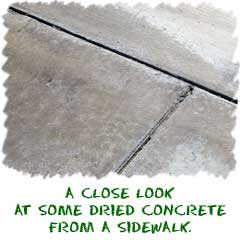
Mixtures Around You
Two classic examples of mixtures are concrete and salt water. If you live near the ocean, they surround you every day. Even if you're inland, you need to remember that your tap water also has many compounds inside, and they act the same way that salt does. Concrete is a mixture of lime (CaO), cement, water(H2O), sand, and other ground-up rocks and solids. All of these ingredients are mixed together. Workers then pour the concrete into a mold and the concrete turns into a solid (as the cement solidifies) with the separate pieces inside. While the cement hardening might be a chemical reaction, the rocks and gravel are held in place by physical forces. They are included in the mixture to increase the strength of concrete. The rocks and gravel are not chemically bonded to the cement. The gravel is also not evenly distributed. There are pieces of gravel here and there. You may have watched building construction before. They mix the concrete for hours to try and get all the little bits mixed evenly. Even with all that mixing, the concentrations of gravel still change from area to area.
While the cement hardening might be a chemical reaction, the rocks and gravel are held in place by physical forces. They are included in the mixture to increase the strength of concrete. The rocks and gravel are not chemically bonded to the cement. The gravel is also not evenly distributed. There are pieces of gravel here and there. You may have watched building construction before. They mix the concrete for hours to try and get all the little bits mixed evenly. Even with all that mixing, the concentrations of gravel still change from area to area.
Salt water is different. First, it's a liquid. Second, it's an ionic solution. Salt molecules separate into sodium (Na+) and chloride (Cl-) ions in the water.
Putting Together and Breaking Apart

The thing to remember about mixtures is that you start with some pieces, combine them, and then you can do something to pull those pieces apart again. You wind up with the same molecules (in the same amounts) that you started with. The way you separate the molecules is as unique as the mixture. We have talked about grinding and boiling. If you have a mixture of salt and tiny pieces of iron (Fe), you can use a magnet to separate the iron from the mixture. Remember that gravity will help you separate both sand and oil from water if you wait a few minutes.
Related Video...
Science of Innovation: Smart Concrete (US-NSF Video)



